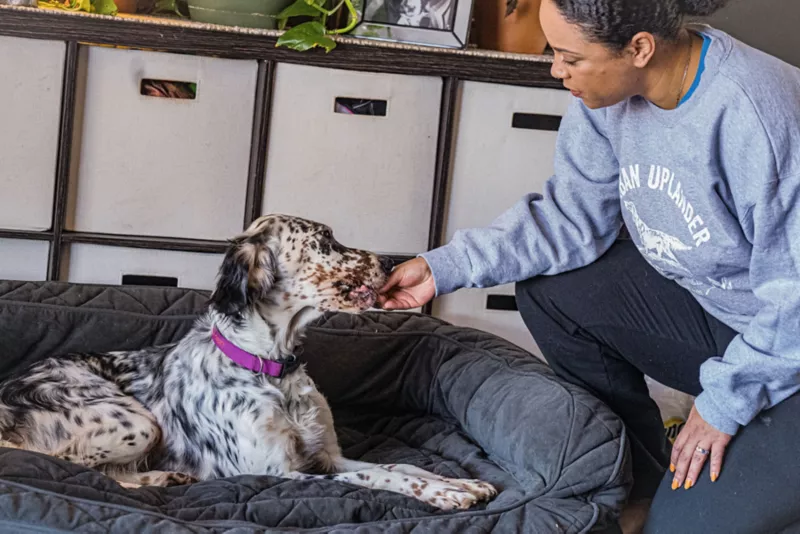Whether you’re dealing with a rambunctious puppy or an independent cat, sleep training can make a difference in their behavior and health. We’ll explore effective strategies for sleep training your pet, helping you create a peaceful nighttime routine that benefits both you and your furry friend.
1. Establish a Bedtime Routine

Consistency is key to successful sleep training, so establish a regular bedtime for your pet and stick to it every night. This helps set their internal clock and signals that it’s time to wind down.
To help them prepare for bed, incorporate calming activities into your pet’s bedtime routine. For dogs, this might include a gentle walk or some quiet playtime to expend any leftover energy. For cats, engaging in a short play session with their favorite toy can help them relax.
2. Create Positive Associations with the Sleep Area
Make the sleeping area a place your pet loves by using treats and toys to create positive associations. For instance, reward your dog with a treat when they enter their crate near your bedroom furniture set or don’t hop onto your adjustable bed.
You should also allow your pet to explore the sleeping area during the day. Let them spend short periods in their bed or crate with the door open, gradually increasing the time they spend there until they feel comfortable and at ease.
3. Set Boundaries

Crate training can effectively help dogs develop good sleep habits. Ensure the crate is a comfortable and inviting space. Start by placing your dog in the crate for short periods during the day, and then gradually extend the time. At night, encourage them to sleep in the crate and reward them for calm behavior.
On the other hand, cats typically prefer to choose their own sleeping spots. Encourage independent sleeping by providing multiple comfortable options throughout your home. To foster independence, avoid letting your cat sleep on your adjustable mattress.
4. Handle Night-time Disturbances
If your pet wakes up and makes noise during the night, avoid immediately attending to them. It’s important not to reinforce negative behaviors like barking, whining or meowing for attention. Instead, wait a few moments to see if they settle down on their own. If they continue, respond to them in a calm, controlled manner without engaging in play or providing attention.
5. Be Patient
Understand that sleep training is a process that requires time. Some pets may take days, weeks or even months to fully adapt to a new sleep routine. The key is to remain patient and persistent, knowing that you’re working toward a goal that will benefit both you and your pet.

Addressing Common Challenges
Sleep training pets can come with a range of challenges. Here are some common issues and how to address them:
- Separation anxiety: Some pets, especially dogs, may experience separation anxiety, which can disrupt sleep training. To alleviate this, practice leaving your pet alone for short periods and gradually increase the time. Provide comfort items, such as a favorite toy or a piece of clothing with your scent, to help soothe them.
- High energy levels: Pets with high energy levels may find it difficult to settle down at bedtime. Ensure they get plenty of physical and mental stimulation during the day. Incorporate activities like walks, playtime and training exercises to help tire them out. A tired pet is more likely to sleep well.
- Multiple pets with different sleep needs: If you have multiple pets, they may have different sleep requirements and habits, which can complicate sleep training. To prevent disturbances, create separate sleeping areas for each pet. Tailor the sleep training routine to suit each pet’s needs and be consistent with boundaries.
- Nighttime noise and disruptions: Pets may react to nighttime noises, such as passing cars or other animals. Use white noise machines or calming music to mask these sounds. Additionally, ensure the sleeping area is as quiet and dark as possible to promote restful sleep.
- Health issues: Sometimes, sleep disturbances can be linked to underlying health issues. If your pet shows signs of discomfort, excessive waking or changes in sleep patterns, consult with a veterinarian to rule out medical problems.

Tips for Long-Term Success
Maintaining successful sleep habits in your pet requires ongoing effort and consistency. Here are some tips for ensuring long-term success:
- Maintain the routine: Consistency is key. Stick to the established bedtime routine even after your pet has adapted. This helps reinforce the sleep schedule and ensures your pet knows what to expect every night.
- Monitor sleep patterns: Regularly observe your pet’s sleep patterns to ensure they’re getting adequate rest. Look for any changes that might indicate discomfort or health issues. Keeping a sleep diary can help track any disruptions or changes.
- Adjust as needed: Be prepared to adjust the sleep routine as your pet’s needs change over time. Factors such as aging, changes in health or lifestyle alterations may require tweaks to the sleep schedule or environment. Stay flexible and responsive to your pet’s evolving needs.
- Provide ongoing exercise and mental stimulation: A well-exercised and mentally stimulated pet is likelier to have restful sleep. Continue to provide daily physical activities and mental challenges to keep your pet engaged and tired by bedtime.
- Positive reinforcement: Continue to use positive reinforcement to encourage good sleep behavior. Reward your pet for settling down calmly at bedtime and for sleeping through the night without disruptions.
- Consult professionals when needed: If you encounter ongoing issues or significant changes in your pet’s sleep behavior, consult a veterinarian or a professional pet trainer. They can provide expert advice and help address any underlying problems.
By following these steps and remaining patient and consistent, you can create a peaceful sleep environment that benefits both you and your pet. With time and effort, your pet will learn to sleep well, leading to happier and healthier days for both of you.




